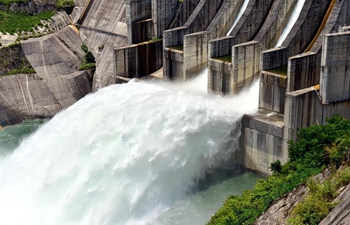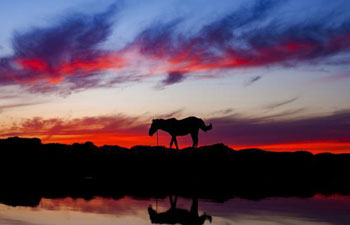NAIROBI, July 26 (Xinhua) -- Kenya said on Wednesday that the increased demand for land and urban development is threatening wildlife conservation that remains the country's main foreign exchange earner.
Ministry of Environment and Natural Resources Cabinet Secretary Judi Wakhungu said on Wednesday that urgent conservation measures must be put in place to save the declining species of wildlife from extinction.
"Kenyan wildlife species has decline by 67 percent between 1977 to 2013, more than a third and continue to be extreme in some species," Wakhungu said during the launch of a report on protection of wildlife corridors and dispersal areas in Kenya.
She noted that the role played by wildlife in the economy is huge since 10 percent of its Gross Domestic Product (GDP) is generated and continues to provide economic benefits at all levels, including support to sustainable livelihoods for rural communities.
"Local communities benefit directly from numerous payments for wildlife conservation through partnerships with tour operators in community-based conservancies across the country hence the need to conserve the wildlife," Wakhungu said.
The report attributes the decline to changes in government land policies and rapid population growth which discourages pastoralism and promotes privatization of land tenure, leading to land sub-division.
It said that agricultural development and settlement policies that promote farming in rangelands exacerbate the destruction of habitats and exclusion of wildlife.
"Cultivation resulting in habitat degradation, fragmentation and loss, constrained seasonal mobility and displacement or exclusion of wildlife from pastoral lands is also to blame for the decline of wildlife," says the report.
The report blames the decline to escalating human-wildlife and land-use conflicts, poaching and expansion of settlements and cultivation into the rangelands.
Wildlife also decline due to inadequacy of national parks and reserves to sustain viable populations of large mammals and diminishing opportunities for expanding existing protected areas.
The East African nation has over 25,000 species of wild animals and 7,000 species of wild plants, making the country as one of the biodiversity-rich countries in the world.
The country is endowed with an extraordinary wealth of mammals, birds and other biodiversity, a unique heritage for the people of Kenya.
"We have over 50 protected areas, across all ecosystems in the country to ensure the diversity of wildlife and its beauty is preserved for present and future generations," Wakhungu said.
The report recommends that to avert and reduce wildlife declines, there is need to urgently secure dispersal areas and migratory corridors.
It calls for the identification and mapping of wildlife dispersal areas and migratory corridors to help the country's spatial planning and guide the process of securing wildlife areas already interfered with by human activities.
It further calls for the creation and developing community and private wildlife conservancies, and diversification of rural livelihoods through benefits from ecosystem services.
"Rationalize and implement the policies, laws and regulations related to land use, wildlife conservation, forestry, water, and agriculture," the report adds.
Wakhungu called for collaboration to help secure space for wildlife and healthy ecosystems for biodiversity conservation and sustainable development.
"Just as the roads and railways are connected and mapped, Kenya's conservation areas and dispersal areas are also going to be connected and mapped," she noted.
The U.S. Ambassador to Kenya Robert Godec called on wildlife experts to conduct regular monitoring and evaluation for effective management of wildlife dispersal areas and migratory corridors.
"Regular consultations on data gathering can help solve the human-wildlife conflict by creating harmony," Godec noted.
The study is based on the recognition that a significant proportion of Kenya's wildlife seasonally or permanently exists outside protected areas and is exposed to increasing human pressures that have negative impacts on species' populations, dispersal areas and migratory corridors.
It has identified and maps wildlife habitats and their desired connectivity.

















